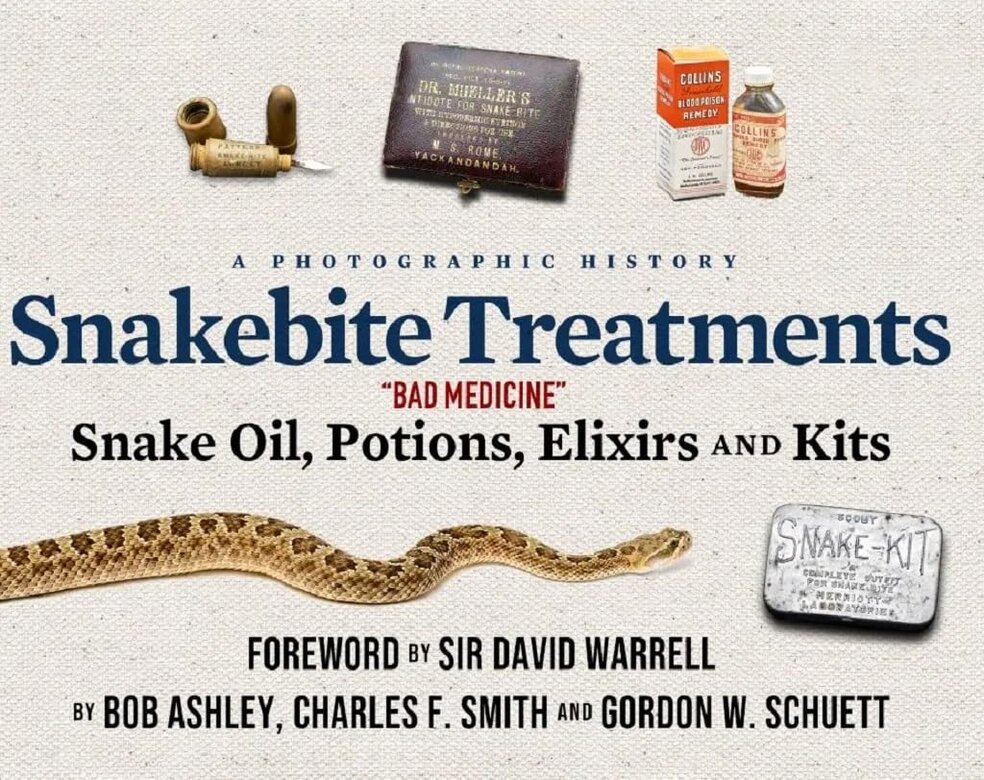An informative and passionately penned book that will leave readers better prepared and protected the next time they cross paths with the slithering species, A Photographic History of Snakebite Treatments: Bad Medicine, Snake Oil, Potions, Elixirs and Kits by Bob Ashley, Charles F. Smith, and Gordon W. Schuett is a surprisingly eye-opening and entertaining account for its niche subject. With more than two million snake bites each year, as well as roughly 100,000 deaths, understanding the dangers of snakebites is a critical issue, particularly in tropical regions, and this book offers both a historical overview and specific treatments that can be used in the field.
Rather than being a strict reference text, the book is a historical curation, combining ideas, anecdotal stories, remedies, and treatment blunders over time. The authors’ historical review begins by exploring the colorful traditions of snakebite remedies, from ancient folklore and indigenous knowledge to the modern advancements of antivenom. The bulk of the text is dedicated to a visual catalog of snakebite kits sourced from various collections, including the museum where author Ashley acts as director. These kits range from simple pocket first-aid packs to ornate cases with colorful cloth interiors and elegant engravings, as though these fast-acting remedies were also fashion accessories. The broad range of kits makes for an anthropological collage of styles and treatments from across the world.
Aside from the images of remedies and their evolution, the brief anecdotes are fascinating and erudite, akin to brief essays on snake facts – from one enigmatic snake that is both poisonous and venomous to explorations of natural selection and envenomation trends across snake species. Many readers might be surprised to learn that saw-scaled vipers are responsible for more human deaths than all other snake species combined, or that reliable anti-venoms were first developed by immunizing birds. Showing obvious love of alliteration and wordplay, the authors make what could be a dense guide and historical review into an engaging read that one could finish in a single afternoon.
While the book is not necessarily intended to be a strict field guide, there is less text than expected, and while the photographic documentation offers a clear and illustrative peek into the past, readers seeking a comprehensive or medical text on snakebite treatment may be disappointed. Undeniably dominated by pictures, as the book’s title suggests, the narrative sections do offer some variety, which reinforces the widespread presence of snakes and their dangers across generations, but the brevity of the captions fails to give readers much additional insight, aside from the kit or serum’s place of origin. From a technical perspective, there is also some inconsistency between in-text references and misspelled words (e.g. Pitsburgh). When there is a limited amount of text in a book like this, the prose must be meticulously edited and carefully chosen, or else it undercuts the book’s authority.
That said, for deep-niche snake aficionados, this is a magnificent lens into the history of snakebite management, with a conversational tone and enough informality to be accessible for any curious reader.
Book Links
STAR RATING
Design
Content
Editing
Get an Editorial Review | Get Amazon Sales & Reviews | Get Edited | Get Beta Readers | Enter the SPR Book Awards | Other Marketing Services
























Leave A Comment